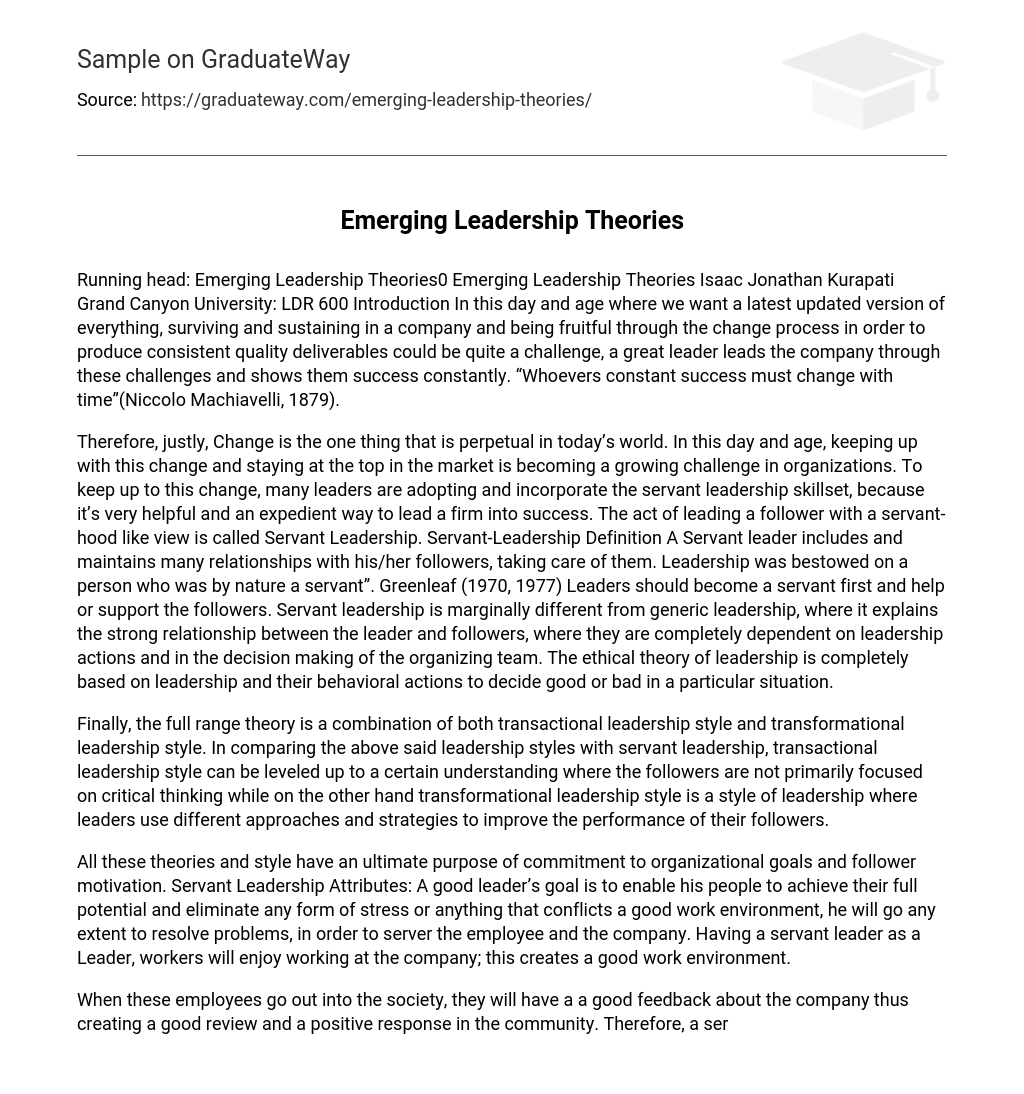Introduction
In today’s fast-paced world, it can be challenging for a company to not only survive but also thrive amidst constant change. Delivering consistent quality products and services requires effective leadership. As Niccolo Machiavelli once said, “Whoevers constant success must change with time” (1879).
Therefore, it is fair to say that perpetual change is the only constant in today’s world. In modern times, organizations face an increasing challenge to stay ahead of the market by keeping pace with this change. Many leaders are embracing and implementing the skillset of servant leadership as a practical and efficient approach to leading their firm to success. Servant leadership is defined as the act of guiding followers with a mindset resembling that of a servant.
Servant-Leadership Definition
According to Greenleaf (1970, 1977), a servant leader is someone who establishes and nurtures multiple relationships with their followers while taking care of them. This type of leadership is characterized by individuals who have an innate desire to serve others. The main objective of a servant leader is to aid and provide support to their followers. While there are similarities between servant leadership and conventional leadership, the key distinction lies in the emphasis on the strong bond between the leader and their followers. In this form of leadership, the followers heavily rely on their leader’s actions and actively participate in organizational decision-making. The ethical theory of leadership primarily focuses on evaluating leadership behavior and actions to determine what is considered morally right or wrong within a specific situation.
The full range theory combines transactional leadership style and transformational leadership style. When comparing these leadership styles with servant leadership, transactional leadership style places less emphasis on critical thinking, while transformational leadership style focuses on using various approaches and strategies to enhance follower performance. All of these theories and styles aim to foster commitment to organizational goals and motivate followers.
Servant Leadership Attributes
A good leader’s goal is to empower their team members and remove stress or conflicts in the work environment. They are committed to resolving issues for the benefit of both employees and the company. Having a servant leader in charge will create a positive work atmosphere, where employees find enjoyment in their work.
A servant leader plays an essential role in a company. When employees interact with the community, they will have a positive impression of the company, leading to good reviews and a favorable response. The servant leader adjusts to market changes and implements those changes within the company, while also eliminating anything that hampers a positive work environment. This leader shows respect and trustworthiness towards their followers, leading to employee satisfaction. Satisfied employees are productive and produce satisfactory results, ultimately satisfying customers, which is the primary goal for any company. A servant leader recognizes, adapts to, and manages changes to fulfill the needs of their people and organization, as well as those they serve. According to Greenleaf (1970, 1977), leadership is inherent in a person who naturally serves.
The essential quality of a good leader is the ability to be a good follower. A servant leader exemplifies this by being a follower themselves. In essence, a leader is ultimately just a proficient follower. A servant leader dedicates themselves to serving and assisting their followers in becoming more knowledgeable, skilled in tasks, and effective in conducting research.
Servant Leadership Application
Many national leaders and politicians in Indian culture, including Mahatma Gandhi, embrace and practice the Greenleaf principles. Gandhi effectively utilizes servant leadership, serving as a prime example of a leader driven by empowering others rather than exerting control over them. He dedicates himself to promoting non-violence and improving the lives of the oppressed, which defines his career. Personally, I find inspiration in Mahatma Gandhi (1869-1948) and aim to embody servant leadership.
Servant Leadership is not just limited to the physical leaders in India; it is also evident in the epic Hindu mythological gods and their manuscripts. The Veda’s state that all Hindus should serve their people in every need and state in order to become a great leader. Additionally, serving the people is seen as equivalent to serving the world. According to Drury (2005), a leader understands that the mission is greater than self and demonstrates behaviors of respect, service, justice, honesty, and community.
References
- Garud , R. , Kumaraswamy, A. , & Sambamurthy, V. (2006). Emergent by design: Performance and transformation at Infosys technologies. (2 ed. , Vol. 17). Mumbai: Informs.
- Harding, P. Government Office for the South West, Office of Sustainable Business. (2004). Managing change. Seattle: www. onesouthwest. om
- Phil Harding. Benioff, M. , & Alder, C. (2006). The business of changing the world. (1 ed. , pp. 93-154).
- New York: McGraw-Hill. Blake, R. R. , & McCanse, A. A. (1991). Leadership dilemmas: Grid solutions. Houston, TX: Gulf Publishing Company.
- Blake, R. R. , & Mouton, J. S. (1964). The managerial grid. Houston, TX: Gulf Publishing Company.
- Blake, R. R. , & Mouton, J. S. (1978). The new managerial grid. Houston, TX: Gulf Publishing Company.





